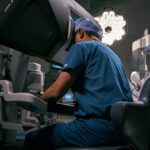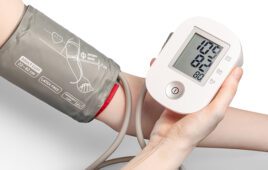Kathryn Rieger, head of human factors and user research at Intuitive Surgical, explains how the surgical robotics developer approaches product design.

Intuitive Surgical Senior Director for Human Factors and User Research Kathryn Rieger [Photo courtesy of Intuitive]
“If you Google it, you will see it is not a very well-designed product,” she recalls. “It was designed to cook six hotdogs in 60 seconds. Essentially, it had these big spikes that you impale the hotdogs onto [and it] was a circuit that you completed like a good old-fashioned science project to cook the hotdogs.”
So what’s the connection between meat-tech and medtech? Rieger found herself facing the frankfurter-frying contraption in her first day of “Bad Product Design,” a college course she took as an undergrad at Tufts University. Her instructor (and future mentor) asked whether it was a good product.
“The answer is no. It’s a terrible product. It’s got these massive spikes and people can get hurt … Some of the points are very obvious about why it’s so bad. Some of them, you start thinking and getting deeper into the conversation. The fun part and the turning point came when he said to me, “OK, so how do you fix it? How do you make it better?” And it was just the most fun exercise and got my brain kicking in a way utilizing science and art and math. And it was just amazing.”
After the class, she called her parents to let them know she had decided on a major, and would go on to graduate with a bachelor’s of science degree in human factors (HF) engineering.
Rieger shared the story with DeviceTalks Editorial Director Tom Salemi for our IntuitiveTalks web series, describing the surgical robotics developer as “the mecca of HF.”
“We get to work on every aspect of systems, from training to labeling to instructions for use, and of course the robot itself and all the interactions there,” she said. “… We’re the glue between the people who make the product and the people who use the product. And they’re not the same.”
Intuitive’s users go beyond surgeons
Rieger explained how Intuitive works with surgeons to design its robotic surgery systems — and said they’re not shy about sharing their opinions as to how Intuitive can improve its product design.
“They’re very passionate about the system and about helping us,” she said. “… We listen. But they’re not always right. That’s just human nature. It’s not their fault. That is, our perception doesn’t always match the reality of our performance. And so those are some of the fun moments when we get to illuminate that to some of our users who are so adamant that adding a paddle is going to be the best way to do something. And we show them an alternate way to do it, and they’re like, ‘Oh, you’re right. That was better.’ Show them the data. Those are really rewarding moments.”
And it goes beyond the surgeon. Intuitive’s human factors team looks at the entire hospital ecosystem to make sure they’re considering all users, especially for newer digital products, but even for a relatively straightforward offering like Integrated Table Motion.
“So just moving the table and the robot moves with the table … it was a new user group to us,” Rieger said. “All of a sudden, there’s an anesthesiologist in the room who’s actually responsible for the patient and moving the table. [We] said, ‘Oh, there’s someone we’ve never talked to. We have a new user and need to understand that user and include them.’ So our user base is growing, and keeps us on our toes.”
Intuitive conducts a “mind-boggling” amount of research, she said: hundreds of studies per year, thousands of user interactions that are documented, logged and analyzed, even a truck built like a mobile operating room that goes out to surgeons.
All of that helps the human factors team find pain points where there are opportunities to make a surgeon’s job easier or help them do it better.
“Cognition is about information processing and decisionmaking. … Social, environmental, looking at all those factors and gathering as much data as we can — it’s our job to translate that into design,” she said.
Intuitive’s human factors inspiration
Rieger summed up Intuitive’s mission as creating “products that are easy to use and easy to learn.”
“Because we’re the pioneers, there’s a little bit of pressure on us,” she said. “We’re defining and setting those expectations for what’s out there in the field. So we have to be very responsible about what interaction mental models we invoke in our users. And of course, we need to demonstrate they’re safe and effective.”
Intuitive draws inspiration from areas outside of medtech to understand how a surgeon or another user expects to interact with technology beyond the operating room, for example, while using their smartphone or driving their car.
And with more competitors entering the market, surgical robotics developers must consider the risks of negative transfer, or a surgeon’s decreased performance due to design differences when switching from one robotic platform to another.
“Things like flashing blue lights — what does that mean in robotic surgery? That does mean something to da Vinci users,” Rieger said. “And so if that da Vinci user then goes on to a different robotic platform, it could have an implication of how they use it. And thus, when that user comes back on to da Vinci, it may also impact their understanding of that blue flashing light.”
Intuitive’s human factors team also keeps negative transfer in mind across its own product line for consistency as the company develops new technology and integrates components, features or products acquired from others. As they learn what works and what doesn’t, they create design rules for the entire portfolio.
“The idea is that all of these products work seamlessly together. So much of it should be invisible to the user. … We’ve had full solutions that are ready to ship where human factors comes in and says, ‘Hey, this is breaking a fundamental principle or rule that we have established for user expectation. We can’t do that,'” she said.
One example was Intuitive’s numbering system for the four-armed da Vinci multiport system versus a single-port system.
“That was a big debate. And we we got data to back up our final decision, which was to be consistent with the da Vinci Xi model,” she said.
Intuitive’s human factors future
The Intuitive human factors team is digging in deep to cognitive load as they add new technologies like augmented reality or virtual reality.
“Surgeons are not the first adopters of technology. That is not their expertise. Their expertise is surgery. We’re asking a lot, and there’s a large potential for overload as we’re looking at layering these different technologies and potential interfaces between the human and the machine,” she said. “We have to be real careful that we are cognizant of what kind of cognitive load that we are placing on them.”
But the goal of surgical robotics isn’t simply to allow surgeons to operate on autopilot, either.
“We definitely don’t want to overload to the point where your brain is running like a slow computer because you’re you’re having to think too much and weed through too much unnecessary information,” she said. “But also, we don’t want to bore you, because we want you to be at your optimal peak performance. The whole idea behind a robot is to augment human performance, make it better.”
As medical device users increasingly expect easier learning curves, Intuitive is also starting to look into ways to delight users with emotional design.
“It’s proven science that if we feel good about something, we will perform better. If we are exhibiting negative emotions towards something, our performance will decline,” Rieger said. “We’re getting into some cool nuances in that space that I think will give us some more room to explore what we can do.”
Listen to the entire interview at DeviceTalks or below.








Interesting article. However, the core human factors problem is a well-researched area in human factors science known as “Function Allocation.” That determines which surgical functions are best left to the human participating in the surgery vs. functions allocated to machine automation.
This problem becomes even more complex when the system must manage hand-offs between the surgeon and the machine automation during complex procedures. No amount of surface human factors optimization will overcome defective function allocation research. That is why we have found in our research that FA is the cornerstone of successful surgical robotic systems design.
Charles L. Mauro MSc CHFP
President / Founder
Mauro Usability Science
https://www.linkedin.com/pulse/3-new-advanced-human-factors-testing-methods-medical-mus-mauro-chfp/?trackingId=WAmgrV2kQj29B9CRnu5ffg%3D%3D